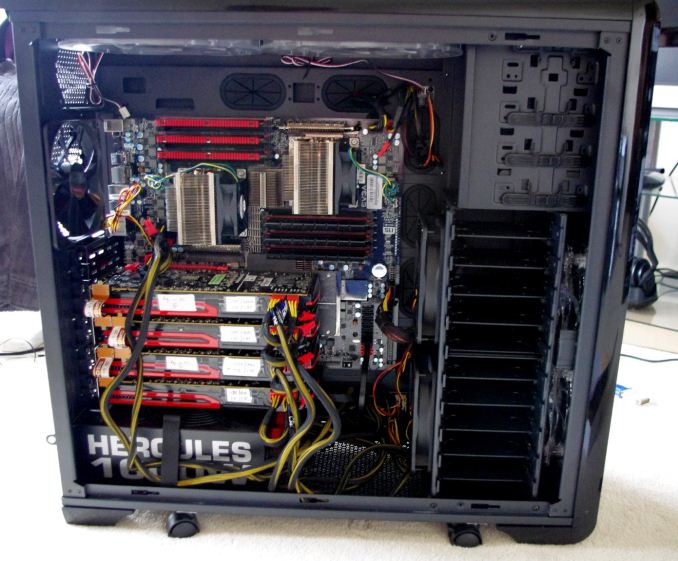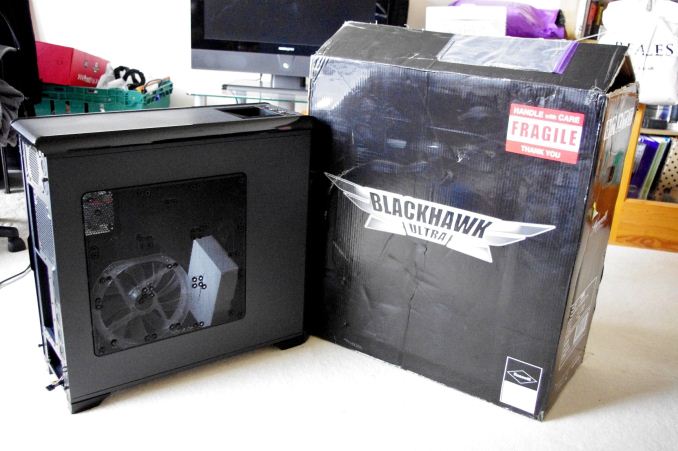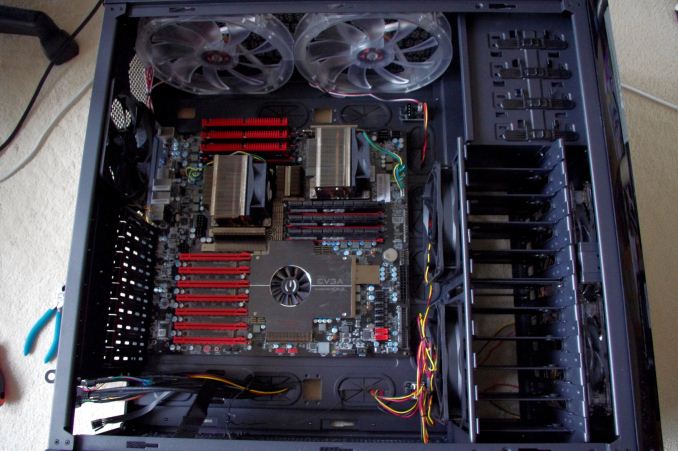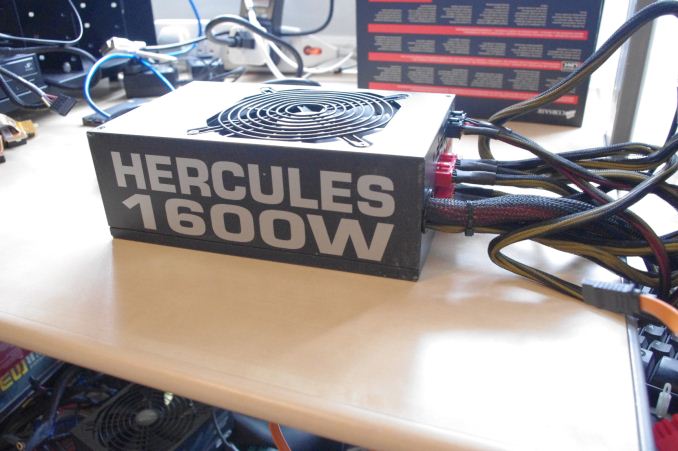Choosing a Gaming CPU: Single + Multi-GPU at 1440p, April 2013
by Ian Cutress on May 8, 2013 10:00 AM ESTTo start, we want to thank the many manufacturers who have donated kit for our test beds in order to make this review, along with many others, possible.
Thank you to OCZ for providing us with 1250W Gold Power Supplies.
Thank you to G.Skill for providing us with the memory kits.
Thank you to ASUS for providing us with the AMD GPUs and some IO Testing kit.
Thank you to ECS for providing us with the NVIDIA GPUs.
Thank you to Corsair for providing us with the Corsair H80i CLC.
Thank you to Rosewill for providing us with the 500W Platinum Power Supply for mITX testing, a BlackHawk Ultra, and 1600W Hercules PSU for extreme dual CPU + quad GPU testing, and RK-9100 keyboards.
Thank you to Gigabyte for providing us with the X5690 CPUs.
Also many thanks go to the manufacturers who over the years have provided review samples which contribute to this review.
Testing Methodology
In order to keep the testing fair, we set strict rules in place for each of these setups. For every new chipset, the SSD was formatted and a fresh installation of the OS was applied. The chipset drivers for the motherboard were installed, along with NVIDIA drivers then AMD drivers. The games were preinstalled on a second partition, but relinked to ensure they worked properly. The games were then tested as follows:
Metro 2033: Benchmark Mode, two runs of four scenes at 1440p, max settings. First run of four is discarded, average of second run is taken (minus outliers).
DiRT 3: Benchmark Mode, four runs of the first scene with 8 cars at 1440p, max settings. Average is taken.
Civilization V: One five minute run of the benchmark mode accessible at the command line, at 1440p and max settings. Results produced are total frames in sets of 60 seconds, average taken.
Sleeping Dogs: Using the Adrenaline benchmark software, four scenes at 1440p in Ultra settings. Average is taken.
If the platform was being used for the next CPU (e.g. Maximus V Formula, moving from FX-8150 to FX-8350), there's no need to reinstall. If the platform is changed for the next test, a full reinstall and setup takes place.
How to Read This Review
Due to the large number of different variables in our review, it is hard to accurately label each data point with all the information about that setup. It also stands to reason that just putting the CPU model is also a bad idea when the same CPU could be in two different motherboards with different GPU lane allocations. There is also the memory aspect to consider, as well as if a motherboard uses MCT at stock. Here is a set of labels correlating to configurations you will see in this review:
CPU[+][(CP)] (PCIe version – lane allocation to GPUs [PLX])
First is the name of the CPU, then an optional + identifier for MCT enabled motherboards. (CP) indicates we are dealing with a Bulldozer derived CPU and using the Core Parking updates. Inside the parentheses is the PCIe version of the lanes we are dealing with, along with the lane allocation to each GPU. The final flag is if a PLX chip is involved in lane allocation.
Thus, for example:
A10-5800K (2 – x16/x16): A10-5800K with two GPUs in PCIe 2.0 mode
A10-5800K (CP) (2 – x16/x16): A10-5800K using Core Parking updates with two GPUs in PCIe 2.0 mode
FX-8350K (2 – x16/x16/x8): FX-8350 with three GPUs in PCIe 2.0 mode
i7-3770K (3/2 – x8/x8 + x4): i7-3770K powering three GPUs in PCIe 3.0 but the third GPU is using the PCIe 2.0 x4 from the chipset
i7-3770K+ (3 – x16): i7-3770K (with MCT) powering one GPU in PCIe 3.0 mode
i7-3770K+ (3 – x8/x8/x8/x8 PLX): i7-3770K (with MCT) powering four GPUs in PCIe 3.0 via a PLX chip
Common Configuration Points
All the system setups below have the following consistent configurations points:
- A fresh install of Windows 7 Ultimate 64-bit
- Either an Intel Stock CPU Cooler, a Corsair H80i CLC or Thermalright TRUE Copper
- OCZ 1250W Gold ZX Series PSUs (Rosewill 1600W Hercules for The Beast)
- Up to 4x ASUS AMD HD 7970 GPUs, using Catalyst 13.1
- Up to 2x ECS NVIDIA GTX 580 GPUs, using GeForce WHQL 310.90
- SSD Boot Drives, either OCZ Vertex 3 128GB or Kingston HyperX 120GB
- LG GH22NS50 Optical Drives
- Open Test Beds, either a DimasTech V2.5 EasyHard or a CoolerMaster Test Lab
AMD Configurations
A6-3650 + Gigabyte A75-UD4H + 16GB DDR3-1866 8-10-10
A8-3850 + ASRock A75 Extreme6 + 16GB DDR3 1866 8-10-10
A8-5600K + Gigabyte F2A85-UP4 + 16GB DDR3-2133 9-10-10
A10-5800K + Gigabyte F2A85-UP4 + 16GB DDR3-2133 9-10-10
X2-555 BE + ASUS Crosshair V Formula + 16GB DDR3 1600 8-8-8
X4-960T + ASUS Crosshair V Formula + 16GB DDR3-1600 8-8-8
X6-1100T + ASUS Crosshair V Formula + 16GB DDR3-1600 8-8-8
FX-8150 + ASUS Crosshair V Formula + 16GB DDR3-2133 10-12-11
FX-8350 + ASUS Crosshair V Formula + 16GB DDR3-2133 9-11-10
FX-8150 + ASUS Crosshair V Formula + 16GB DDR3-2133 10-12-11 + CP
FX-8350 + ASUS Crosshair V Formula + 16GB DDR3-2133 9-11-10 + CP
Intel Configurations
E6400 + MSI i975X Platinum + 4GB DDR2-666 5-6-6
E6700 + ASUS P965 Commando + 4GB DDR2-666 4-5-5
Celeron G465 + ASUS Maximus V Formula + 16GB DDR3-2133 9-11-11
i5-2500K + ASUS Maximus V Formula + 16GB DDR3-2133 9-11-11
i7-2600K + ASUS Maximus V Formula + 16GB DDR3-2133 9-11-11
i3-3225 + ASUS Maximus V Formula + 16GB DDR3-2400 10-12-12
i7-3770K + Gigabyte Z77X-UP7 + 16GB DDR3-2133 9-11-11
i7-3770K + ASUS Maximus V Formula + 16GB DDR3-2400 9-11-11
i7-3770K + Gigabyte G1.Sniper M3 + 16GB DDR3-2400 9-11-11
i7-3930K + ASUS Rampage IV Extreme + 16GB DDR3-2133 10-12-12
i7-3960X + ASRock X79 Professional 16GB DDR3-2133 10-12-12
Xeon X5690 + EVGA SR-2 + 6GB DDR3 1333 6-7-7
2x Xeon X5690 + EVGA SR-2 + 9GB DDR3 1333 6-7-7
The Beast
The Beast is a special machine put together to help with the review as a result of various hardware coming into my possession all at the same time. The core of the system is an EVGA SR-2 motherboard, the best and last dual processor motherboard to deal with overclockable Xeon processors. This is paired with a couple of X5690 Xeon processors, the highest clocked Westmere Xeon that Intel offers, and many thanks to Gigabyte for loaning these to us for a pair of reviews. I went and purchased a pair of Intel Xeon socket 1567 coolers for the system, which have a 2U z-height restriction but are copper piped and cooled by powerful (and loud) delta fans. These provided enough cooling power to push the Xeons from 3.43GHz to 4.6GHz during some overclocking attempts, so are more than adequate for the job at hand (if you can put up with the noise).
Our system is paired with some high quality DDR3 Hyper memory, once famed for its overclocking prowess but due to frequent deaths from high voltage, is now relegated as a memory for overclockers. However at stock this memory performs great, often in the region of DDR3-2000 C7, so our memory kits are well primed for this setup.
Of course a full system is nothing without a case and power supply to help justify a build. With the motherboard being absolutely huge, no standard case would take it – only large cases designed for desktop-based server 2P motherboards are adequate. Luckily there is one case which is selling well, and Dustin reviewed recently – the Rosewill Blackhawk Ultra. Aside from the weight, this case had no issues with installing the motherboard; it could easily fit in another 10 HDDs, four optical bays, and any major GPU setup you could possibly think of – with plenty of fans just for good measure. Read Dustin’s review for a more thorough analysis, but I have some good shots of the system and motherboard installed for you:
Rosewill also has the perfect power supply for dealing with a dual processor, quad CrossFireX setup. First, consider how many connections this 2P setup needs – we have a normal 24-pin ATX connector for the motherboard, one 8-pin CPU power connector for each CPU, an additional 6-pin PCIe power connector for each CPU to provide extra power, another 6-pin PCIe power connector to provide power to the PCIe slots, and then two 6+2 PCIe power connectors for the GPUs. That makes 11 PCIe connectors needed in total, and this is alongside all the fans in the case and whatever SSD/ODD setup a user wants. The power supply used for this monster is the 1600W Hercules, rated 80PLUS Silver. With access to 16 PCIe connectors, the only way you might need any more is with a compute rig having seven single slot cards each needing two connectors. With the CPUs and GPUs both overclocked, our system was drawing almost 1500W at the wall (at a 240V source) under a high CPU+GPU load.
Using a 2P system as a desktop comes with its own set of issues, namely some CPU benchmarks not optimized for 2P, or in this case, some trouble getting some games to even work. It seems that the more money you can throw at a gaming system the more problems start to arise, but The Beast provides a nice comparison point when we look at high-end Ivy Bridge, Sandy Bridge-E and Piledriver processors in multiple-GPU setups.
Our first port of call with all our testing is CPU throughput analysis, using our regular motherboard review benchmarks.
































242 Comments
View All Comments
Dribble - Wednesday, May 8, 2013 - link
Mmm, not done by a true gamer as it doesn't address a number of things:1) Not everyone wants to run the game at max settings getting 30fps. Many want 60, or in my case 120fps as that's what my monitor can do. To do this we turn down graphics a bit, but this makes us much more likely to be cpu bound. Remember generally you can turn down the graphics settings to ease strain on gpu for higher fps, but cpu settings are much more fixed - you can't lower the resolution or turn of AA to fix cpu bottlenecks!
2) Min fps is key, not average fps. This I learned years ago playing ut2004. That game might return 60fps most of the time while admiring the scenery, but when you were in the middle of an intense fight with multiple players fps could half or even quarter. It's obviously in the middle of a firefight that you most need the high fps to win.
3) There's a huge difference between single player games and online. Basically most single player games also run on consoles so they run like a dream on most PC cpu's as even the slower ones are more powerful. However go onto a 64 player server (which a console can't do) and watch the fps tank - suddenly the cpu is being worked much harder. BF3, UT engined games all do this when you get on a large server.
Hence your conclusions are wrong imo. You want an o/c intel quad core - i5 750 o/c to about 4ghz+ or better really. Why that - because basically it's still not far of as fast as you'll get - the latest intel cpu's still have 4 cores, ipc isn't much better and only clock a little higher then that.
maximumGPU - Wednesday, May 8, 2013 - link
i'm pretty sure there's a sizeable jump moving from an i5 750 to 3570K, in both ipc and potential for overclock.Dribble - Wednesday, May 8, 2013 - link
I suppose it depends on what you define "sizable" as? Perhaps a i2500K would be better, but even with a i5 750 @4ghz vs a i3570K@4.5ghz we aren't talking huge increases in cpu power - 25-30% maybe (hyperthreading aside which generally isn't much help in games).IanCutress - Wednesday, May 8, 2013 - link
I very much played a lot of clan-based BF2/BF2142 for a long while. 'True Gamer' is often a misnomer anyway, perpetuated by those who want to categorize others or want to announce their own true nature.1) The push will always be towards the highest settings at which you can hit that 60-120 FPS ideal. If some of the games we see today can't hit 60 on a single GPU at 1440p, at 4K it's all going to tank. Many games tested in this review hit 60+ above two GPUs which was the point of this article to begin with.
2) Min FPS falls under the issue of statistical reporting. If you run a game benchmark (Dirt3) and in one scene of genuine gameplay there is a 6-car pileup, it would show the min FPS of that one scene. So if that happened on an FX-8350 and min-FPS was down to 20 FPS when others didn't have this scene were around 90 FPS for minimum, how is that easily reported and conveyed in a reasonable way to the public? A certain amount of acknowledgement is made on the fact that we're taking overall average numbers, and that users would apply brain matter with regard to an 'average minimum'.
3) This is a bit obvious, but try doing 1400 tests on 64 player servers and keeping any level of consistency. If this is your usage scenario, then you'll know what concessions you will have to make.
An i5-750 using an older chipset also suffers from less of the newer features - native SATA 6Gbps for example for an awesome RAID-0 setup. This could be the limiting factor in your gaming PC. We will be testing that generation for the next update of this testing :)
As written in the review, the numbers we have taken are but a small subset of everything that is possible, and we can only draw conclusions from the numbers we have taken. There are other numbers available online which may be more relevant to you, but these are the ones under our test-bed situations. Your setup is different from someone elses, which is a different usage scenario from others - testing them all would require a few years in Narnia. But suggestions are more than welcome!
Ian
darckhart - Wednesday, May 8, 2013 - link
I agree with Dribble's post above, but your reply was also well thought and written, just like your article. Keep up the good work. Thanks!Dribble - Wednesday, May 8, 2013 - link
I suppose "true gamer" does sound a bit elitist, by that I really meant someone who plays not benchmarks. I agree it's hard to test min fps in 64 player BF3 matches, but that's the sort of moment when your choice of cpu matters, not in for example in a canned off-line BF3 benchmark. As you are advising on cpu buying choices for gaming it is pretty important.My personal experience is the offline canned benchmarks giving average fps say you require a cpu a lot less powerful then you really do when you take your fancy new rig online in the latest super popular multi player game. Particularly as in that game you pretty quickly start playing to win and are willing to sacrifice some fancy settings to get the fps up so you don't loose again as you try to hit that annoying fast moving 15 year old while your fps is tanking :)
Therefore while it's fine to advise those people who only want to play offline console ports using benchmarking as you did, it's just doesn't work for the rest of us.
JarredWalton - Wednesday, May 8, 2013 - link
It sounds more than a bit elitist: it is elitist. For every gamer that spends 10-20 hours of time each week in multiplayer gaming (MMORPG, or whatever FPS you want to name, or World of Tanks, etc.), there are likely at least ten times as many gamers that generally stick to single player games. What's more, that sort of definition of "true gamer" may as well just say "high school or early 20s with little life outside of the digital realm." Yes, that's a relatively big demographic, but there are many 20, 30, 40, and even 50-somethings that still play a fair amount of games, but never bother with the multiplayer stuff. In fact, I'd say that of the 30+ year old people I know well, less than 1% would meet your "true gamer" requirement, while 5% would still be "gamers".Says the 39 year old fuddy duddy.
Spunjji - Wednesday, May 8, 2013 - link
The purpose of this article is to give a scientific basis for comparison within the boundaries of realistic testing deadlines. I would be interested to see you produce something as statistically rigorous based on performance numbers taken from online gaming. If you managed to do it before said numbers became irrelevant due to changes to the game code I would be utterly flabbergasted.Dribble - Thursday, May 9, 2013 - link
No, the purpose of this article is to recommend cpu's for gaming.frozen ox - Thursday, May 9, 2013 - link
There is no way to recreate or capture all the variables/scenarios to repeatedly benchmark a firefight in BF3 across multiple systems. The results from this hardware review are relevant, because they are easily repeatable by others and provide a fair baseline to compare systems. The point of this study is not what CPU do I need to play BF3 or Crysis at max settings, it's how much bandwidth bottleneck is going on with a single GPU setup? What happens in reality with multi-GPU setups? How well does the new AMD architecture (because "true gamers" want to save $$ to buy games) compare to Intel?What you have to do, as a "true gamer" and someone who has enough wits about them, is extrapolate the results to your scenario because everyone's will be different. And honestly, anyone who plays FPS...the "true gamers", will know what you pointed out. It's insanely obvious even the first time you play a demanding FPS MMPOG like BF3.
I however, play single player 99% of the time. Only online FPS I'll play now is CS.